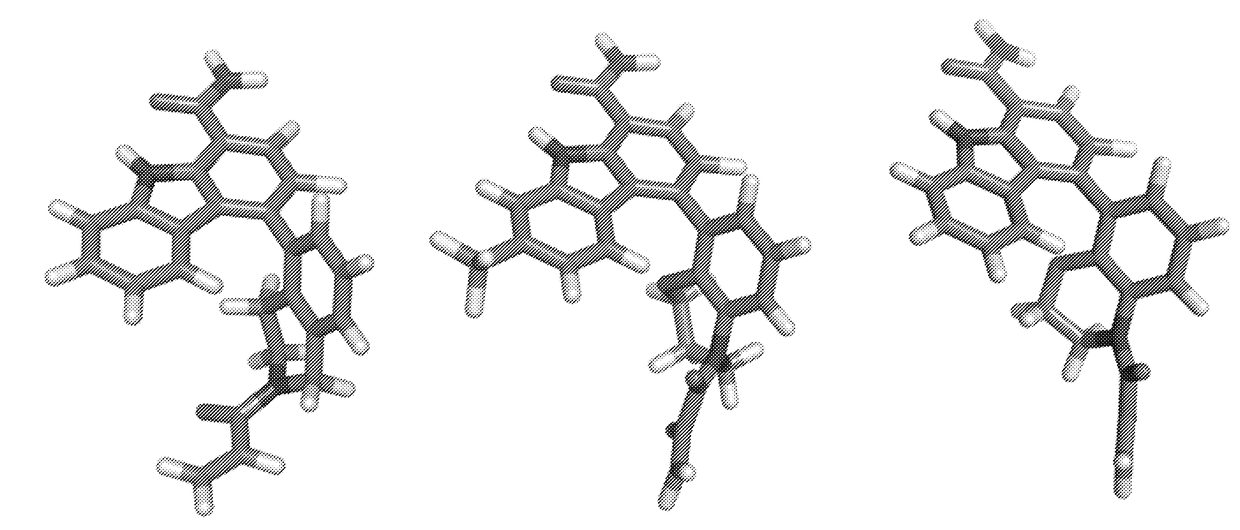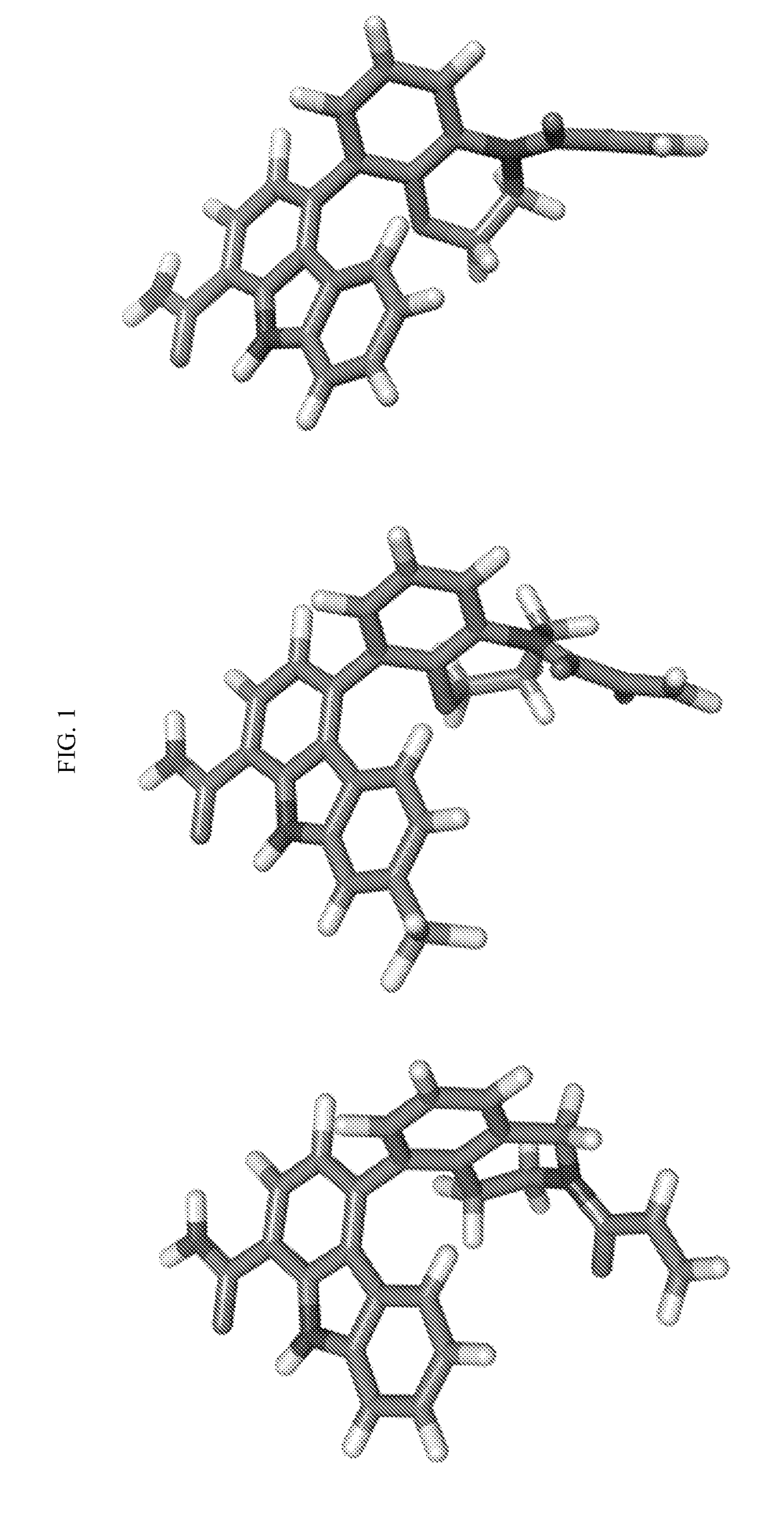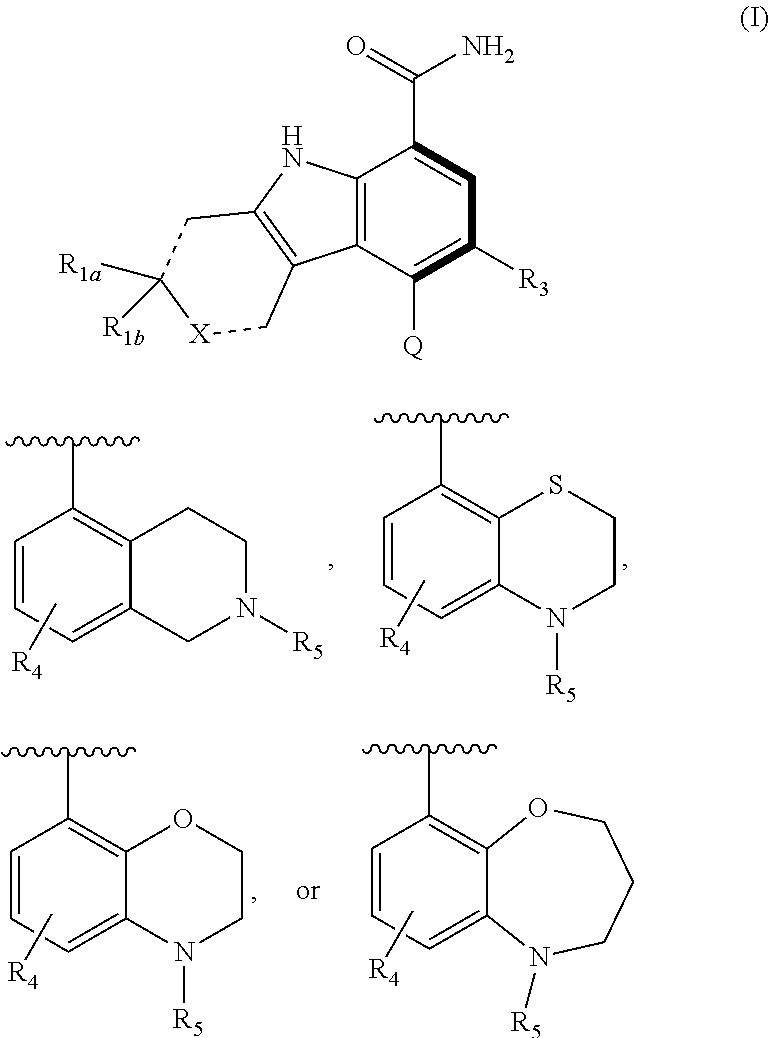Tricyclic atropisomer compounds
a technology of atropisomer and compound, which is applied in the field of tricyclic atropisomer compounds, can solve the problems of marked improvement of disease progression, inhibitors that may have undesired effects, and may not easily form covalent bonds
- Summary
- Abstract
- Description
- Claims
- Application Information
AI Technical Summary
Benefits of technology
Problems solved by technology
Method used
Image
Examples
example 1
(RS)-5-(2-Acryloyl-1,2,3,4-tetrahydroisoquinolin-5-yl)-3,3,6-trifluoro-2,3,4,9-tetrahydro-1H-carbazole-8-carboxamide
[0297]
[0298]A mixture of 3,3,6-trifluoro-5-(1,2,3,4-tetrahydroisoquinolin-5-yl)-2,3,4,9-tetrahydro-1H-carbazole-8-carboxamide [Intermediate 12] (47 mg, 0.118 mmol) and DIEA (62 μL, 0.353 mmol) in 3:1 DCM-THF (0.5 mL), was treated at 0° C. with acryloyl chloride (11 μl, 0.129 mmol). After stirring for 10 min, the mixture was diluted with DCM, washed with water, dried and concentrated. The residue was triturated with EtOAc to provide (RS)-5-(2-acryloyl-1,2,3,4-tetrahydroisoquinolin-5-yl)-3,3,6-trifluoro-2,3,4,9-tetrahydro-1H-carbazole-8-carboxamide as a white solid (47 mg, 84% yield). Mass spectrum m / z 454 (M+H)+. 1H NMR (500 MHz, DMSO-d6) δ 11.20 (s, 1H), 8.14 (br. s., 1H), 7.62 (d, J=10.7 Hz, 1H), 7.55 (br. s., 1H), 7.42-7.26 (m, 2H), 7.19-7.11 (m, 1H), 7.00-6.70 (m, 1H), 6.14 (d, J=16.6 Hz, 1H), 5.88-5.62 (m, 1H), 4.95-4.66 (m, 2H), 3.80-3.48 (m, 2H), 2.94 (t, J=5.5 H...
example 5
4-(2-Acryloyl-1,2,3,4-tetrahydroisoquinolin-5-yl)-3-fluoro-9H-carbazole-1-carboxamide (single enantiomeric atropisomer)
[0300]
[0301]A sample of (RS)-4-(2-acryloyl-1,2,3,4-tetrahydroisoquinolin-5-yl)-3-fluoro-9H-carbazole-1-carboxamide [Example 2] (13 mg) was separated by chiral super-critical fluid chromatography (Column: CHIRALCEL® AS-H (3×25 cm, 5 μm); Mobile Phase: CO2-MeOH (70:30) at 150 mL / min, 100 bars, 35° C.; sample preparation: 3 mg / mL in MeOH; injection: 1.5 mL). The first peak eluting from the column provided one enantiomeric atropisomer of 4-(2-acryloyl-1,2,3,4-tetrahydroisoquinolin-5-yl)-3-fluoro-9H-carbazole-1-carboxamide [Example 5] (5.2 mg). Mass spectrum m / z 414 (M+H)+. 1H NMR (400 MHz, DMSO-d6) δ 11.55 (s, 1H), 8.25 (br. s., 1H), 7.99 (d, J=10.6 Hz, 1H), 7.74 (d, J=8.2 Hz, 1H), 7.66 (br. s., 1H), 7.53-7.39 (m, 2H), 7.38-7.17 (m, 2H), 7.08-6.54 (m, 3H), 6.28-6.01 (m, 1H), 5.83-5.54 (m, 1H), 5.12-4.69 (m, 2H), 3.89-3.41 (m, 2H), 2.71-2.28 (m, 2H, buried under residual...
example 6
5-(2-Acryloyl-1,2,3,4-tetrahydroisoquinolin-5-yl)-3,3,6-trifluoro-2,3,4,9-tetrahydro-1H-carbazole-8-carboxamide (single enantiomeric atropisomer)
[0302]
[0303]A sample of (RS)-5-(2-acryloyl-1,2,3,4-tetrahydroisoquinolin-5-yl)-3,3,6-trifluoro-2,3,4,9-tetrahydro-1H-carbazole-8-carboxamide [Example 1] (42 mg) was separated by chiral super-critical fluid chromatography (Column: CHIRALCEL® AS-H (3×25 cm, 5 μm); Mobile Phase: CO2-MeOH (65-35) at 150 mL / min, 100 bars, 35° C.; sample preparation: 7 mg / mL in MeOH-DMF (9:1); injection: 1.75 mL). The first peak eluting from the column provided one enantiomeric atropisomer of 5-(2-acryloyl-1,2,3,4-tetrahydroisoquinolin-5-yl)-3,3,6-trifluoro-2,3,4,9-tetrahydro-1H-carbazole-8-carboxamide [Example 6] (5 mg). Mass spectrum m / z 454 (M+H)+. 1H NMR (400 MHz, MeOH-d4) δ 7.50 (d, J=10.6 Hz, 1H), 7.41-7.31 (m, 2H), 7.19 (d, J=3.3 Hz, 1H), 6.97-6.70 (m, 1H), 6.25 (dd, J=16.7, 1.8 Hz, 1H), 5.84-5.70 (m, 1H), 4.98-4.86 (m, 2H), 3.93-3.78 (m, 1H), 3.78-3.53 (m...
PUM
| Property | Measurement | Unit |
|---|---|---|
| Structure | aaaaa | aaaaa |
Abstract
Description
Claims
Application Information
 Login to View More
Login to View More - R&D
- Intellectual Property
- Life Sciences
- Materials
- Tech Scout
- Unparalleled Data Quality
- Higher Quality Content
- 60% Fewer Hallucinations
Browse by: Latest US Patents, China's latest patents, Technical Efficacy Thesaurus, Application Domain, Technology Topic, Popular Technical Reports.
© 2025 PatSnap. All rights reserved.Legal|Privacy policy|Modern Slavery Act Transparency Statement|Sitemap|About US| Contact US: help@patsnap.com



